- Home
- Encyclopedia
- Kathy Karpan: A Life In Law and Politics
Kathy Karpan: A Life in Law and Politics
The young woman in the plaid jumper could hardly contain her excitement as she stood in a crowd outside the University of Wyoming field house after President John F. Kennedy spoke there in late September 1963.
Kathy Karpan, editor of the UW student newspaper, introduced herself and two staffers standing next to her. President Kennedy moved on and then came back to Karpan to ask, “What’s the name of the student newspaper?” Karpan replied: “The Branding Iron.” It took a second to register, and then he smiled and said, “That’s clever.”
Less than two months later, President Kennedy was killed by an assassin’s bullet. But Kathy Karpan’s remarkable Wyoming political career was well on its way.
“They say your personality is set by the time you are 6 years old,” says Karpan. “In first grade, I knew that I was a Catholic and a Democrat.”
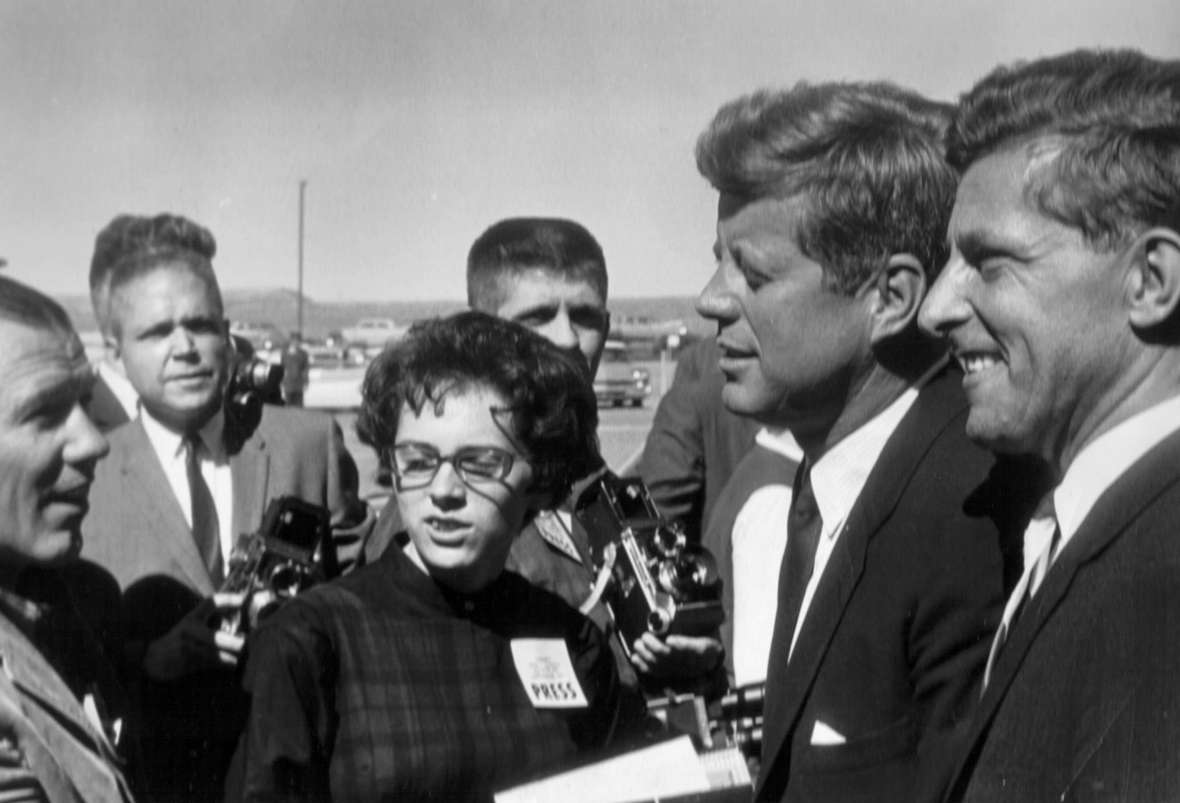
Karpan was born in Rock Springs, Wyo., in 1942, the first child of Thomas and Pauline Taucher Karpan. Growing up in the heart of what was then Wyoming’s unionized coal country, she “didn’t know there was a Republican Party.”
While still only in elementary school, Karpan pedaled her bicycle to the county Democratic headquarters on M Street in Rock Springs to get an Adlai Stevenson bumper sticker, which she threaded through the spokes on her bike.
Injuries from a mine cave-in ended Thomas Karpan’s career as a coal miner, and he went to work for the Union Pacific Railroad on the short, 25-mile “mine run” from Rock Springs to Superior. In 1952, the UPRR switched to diesel and closed its coal mines, “nearly killing Rock Springs,” according to his daughter. The end of the mine line precipitated a family move to Rawlins when Thomas Karpan was transferred to the UPRR’s main line across southern Wyoming.
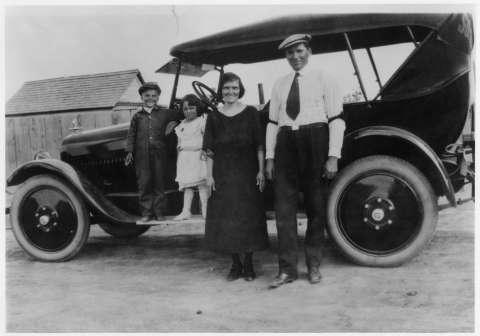
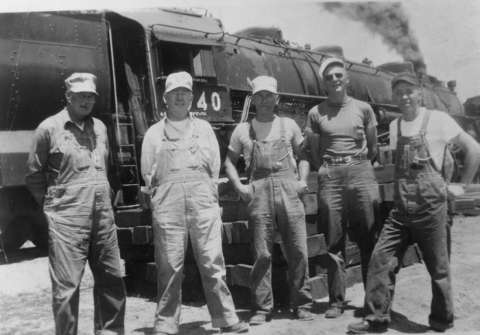
Pauline Karpan’s health was in decline at the time of the move, however, and she passed away in December 1954, a day after her 37th birthday. Thomas Karpan moved back to Rock Springs, where relatives could help him take care of the children—Kathy and her two younger siblings, Judy and Frank; consideration was given to sending them to St. Joseph’s Children’s Home in Torrington. Then only 12 years old, Kathy tearfully implored her father to keep the children together at home, promising to “do everything you say.” She helped care for them through a move back to Rawlins, where she graduated from high school in 1960.
College didn’t appear to be in the cards for a young woman with family responsibilities and limited resources. But on the night of her high school graduation, she learned she had won a scholarship to the UW College of Commerce and Industry. Karpan duly presented herself in Laramie that fall and was told, “secretarial science is down that hall.”
Discovering later that she qualified for the honors program, Karpan changed her major to journalism and served as editor of The Branding Iron during the spring and fall of 1963–when she met President Kennedy–and the spring of 1964.
Karpan considers herself “part of the generation inspired by JFK,” and she “secretly hoped I’d get into politics.” She approached the head of UW’s journalism department about getting a job with U.S. Sen. Gale McGee, formerly a UW history professor. McGee’s office was fully staffed, but Karpan’s friend and law student Bill Bagley made a connection with Wyoming’s freshman congressman, Rep. Teno Roncalio of Rock Springs. Roncalio and McGee were both Democrats.
By this time, Karpan had taken her first journalism job, at the Cody Enterprise. Roncalio called her and offered her a job as secretary. Karpan balked, thinking back to the bad old days of secretarial science. “I have a degree in journalism,” she told Roncalio. “I’m not going to be a secretary.” Roncalio replied, “I’m asking you to be my press secretary.” Karpan accepted.
Washington in a heady time
“You can’t imagine how heady it was to be in Washington at that time,” said Karpan. “We all had tickets to LBJ’s [President Lyndon Baines Johnson] 1965 State of the Union address. To look down and see Teno sitting with the Kennedys … It was incredible.”
Heady days can pass quickly in politics. Wyoming Democrats held high hopes for the 1966 election. LBJ had carried the state in 1964, and swept Democrats into a rare majority in the Wyoming House of Representatives. But the dreams for 1966 were not to be. All the statewide Democratic candidates were defeated, including Roncalio, who had run for an open U.S. Senate seat; he lost to Cliff Hansen, who was then just completing a four-year term as Wyoming’s governor. “That was the most heartbreaking defeat in my life, more than my own,” said Karpan.
The turbulent sixties
Looking for a change of scene, Karpan took some short-term jobs and began a desultory effort toward a master’s degree in American Studies at UW. “I was not a stellar student,” Karpan said, “and there was a lot of protesting and dinking around.”
The protesting included opposing the dismissal of the Black 14 from the UW football team in October 1969 and participating in a march against the Vietnam War in Washington, D.C., a month later. Karpan wrote about the march for an unofficial student publication, Free Lunch, “a high-calorie chewspaper where the effete meet to eat”—a takeoff on then-Vice President Spiro Agnew's October 1969 description of Vietnam War protestors as “... an effete corps of impudent snobs who characterize themselves as intellectuals.” In the midst of these distractions Karpan finished her coursework, but couldn’t come up with a thesis topic.
A connection through friends landed her a journalism job in Canberra, Australia, where she again breathed political air in that nation’s capital. After she had worked in Canberra several months, rewriting stories from print media for broadcast media, she received a letter from Roncalio. He had run again for U.S. House in 1970 and won. Karpan served as Roncalio’s chief of staff for the next four years.

In January 1975, Karpan left Washington and returned to Wyoming to finish her master’s thesis on the political career of Democrat Jack Gage, who was elected as Wyoming’s secretary of state in 1958 and briefly served as governor. “I knew I had to finish that thesis before I went to law school, or I wouldn’t,” Karpan said. She did, and then graduated from law school in 1978 from the University of Oregon.
Karpan took her freshly minted law degree back to Washington, D.C., to seek her fortune—and possibly get back into politics. She landed a job with the Economic Development Administration (EDA) in the Department of Commerce as the deputy director for congressional relations, then became the acting deputy legal counsel after passing the district bar exam. But when it became clear that the Republicans were coming to town after the election of President Ronald Reagan in 1980, Karpan made plans to return to Wyoming.
Into Wyoming politics
She quickly was pulled into politics as manager of Democrat Rodger McDaniel’s 1982 campaign for the U.S. Senate against incumbent Republican Malcolm Wallop. Like Karpan, McDaniel had an early start as a Democrat; he was elected to the Wyoming House in 1970 when he was only 21, and subsequently elected to the Wyoming Senate, where he served until 1982. And like Karpan, he was a former Roncalio staffer.
Wallop was one of the first Wyoming politicians to employ campaign consultants and pollsters, and later-famous Roger Ailes—currently Chairman and CEO of Fox News and the Fox Television Stations Group—consulted for Wallop’s 1982 campaign. The campaign was rough-and-tumble by Wyoming standards, with both Republican incumbents U.S. Rep. Dick Cheney and U.S. Sen. Alan Simpson throwing their weight against McDaniel.
“Although we raised more than $400,000—more than any Wyoming Senate campaign had raised to date—Wallop raised over a million dollars,” McDaniel recalls. “Kathy and I used to tell each other that this campaign would be the test of whether money and East Coast consultants could overcome a grassroots campaign.” The grassroots lost the test when Wallop won: 57 percent to McDaniel’s 43 percent. Karpan needed to look for a new job.
She found one in the Wyoming attorney general’s office under Attorney General Archie McClintock, who was appointed by three-term Democratic Gov. Ed Herschler. Among other assignments, Karpan represented boards and commissions, including the Wyoming Board of Medicine.
Dr. Story case
This seemingly routine duty became anything but after the Board of Medicine received complaints about Dr. John Story, a general practice physician in Lovell, Wyo. Several female patients accused Story of sexual misconduct.
Karpan recalls that the women’s previous accusations “were not taken seriously” by the Board of Medicine. From 1983 to 1984, Karpan investigated, made the appropriate filings and introduced evidence for what was only the second contested case hearing in Wyoming history on revocation of a doctor’s license. Karpan also handled the first contested case hearing, against a doctor in Douglas.
The Board of Medicine revoked Story’s license; he appealed and lost. The revocation of his license gave more of his former patients the courage to come forward. The Big Horn County attorney filed criminal charges against Story, who was convicted and sent to prison.
Department of Health
By this point, Karpan was beginning to feel a bit like a lightning rod. This feeling was reinforced one day when Gov. Herschler called her into his office. “I need a new director for the Department of Health,” he told her. Karpan assumed he was going to ask her for names. “I think it should be you,” Herschler said.
Karpan took the helm of the state’s sprawling Department of Health and Social Services in December 1984. There were four divisions: Health and Medical Services, Public Assistance and Social Services, Community Programs and Vocational Rehabilitation. She remembers looking at the budget in horror, with no idea what went where. To further complicate matters, Karpan also inherited a legislative budget footnote mandating the reduction of 10 positions.
Karpan put her administrative skills to work. She reorganized the budget by program so that dollars went with their purpose. The department had offices in every county to provide direct service to clients; Karpan concluded these jobs were the priority and eliminated the 10 positions in administration instead of simply cutting vacant slots.
Secretary of state
When longtime Wyoming Secretary of State Thyra Thomson decided not to run again in 1986, friends approached Karpan about running for the office. In Wyoming, the person holding the position also functions as the lieutenant governor. Karpan resigned as director of the Department of Health in May 1986 and ran her campaign from then until Election Day, winning with 54 percent of the vote against Thomson’s son, K.C. Thomson. Wyoming voters returned Karpan to the secretary of state’s office in 1990 with a 64 percent margin against Republican Tom Zollinger. Karpan carried every county.
Karpan looks back with delight at her eight years as secretary of state, even though the proverbial lightning found her again. “We had to run the first statewide special election ever in Wyoming, when Dick Cheney resigned his congressional seat [in 1989] to become President Bush’s [Republican George H.W. Bush] Secretary of Defense,” Karpan said. “We had to fashion an elections process out of the very spare statutory language about special elections.”
“Then there was reapportionment,” she said with a grin, referring to the lawsuit Gorin v. Karpan, which led to legislative reapportionment[1]. Although the Legislature itself is the architect of reapportionment, Karpan–in her secretary of state responsibility as chief elections officer—had to stand as the target of the lawsuit.
Gorin v. Karpan changed Wyoming’s system of electing legislators from counties to a system of electing legislators from districts drawn according to population; most were wholly within a county, while others crossed one or more county lines. “Once again, we had to forge ahead without much guidance from the law,” said Karpan. “We focused on helping the county clerks implement the new system on the ground, redrawing precinct boundaries in the most workable way.”
Karpan and Margy White, who served as Karpan’s co-counsel on the Story case and became Karpan’s deputy secretary of state, also brought the office into the modern age, transitioning from paper to electronic recordkeeping.
Races for governor and U.S. Senate
With two terms behind her as secretary of state, it seemed natural to run for governor in 1994 when Democrat Mike Sullivan ended his two terms in that office. Democrats had held the governorship since 1974, when Ed Herschler was elected and served for three terms prior to Sullivan.
However, the politics of the country—and of Wyoming—had shifted. “No matter what their party, many Wyoming voters used to go down their ballots and cross from one side to the other,” Karpan said, meaning that the voters chose by person rather than by political affiliation. “But although the exit polling on Election Day 1994 showed that [Gov.] Mike [Sullivan] and I were in the 70 percents on approval of our jobs and likeability, I got 40 percent and Mike got 39 percent! After the election, so many people actually came up to say, ‘I like you and I think you did a good job. But I just don’t like Bill Clinton,’” the Democratic U.S. President who had been elected two years earlier.
Apparently a lot of Wyoming voters didn’t care for Bill Clinton. Republican Jim Geringer won the governor’s race with 59 percent of the vote to Karpan’s 40 percent. Mike Sullivan, who was running for U.S. Senate against Republican Craig Thomas, mustered the aforementioned 39 percent against Thomas’s 59 percent.
Karpan returned to practicing law with her former secretary of state deputy, Margy White. Karpan also taught a course on Wyoming state government at Laramie County Community College in 1995 followed by political science classes at UW as the Milward Simpson Fellow during spring semester 1996.
As fate would have it, Milward Simpson’s son Alan Simpson, a longtime U.S. Senator, announced he would retire and not run for re-election in 1996. Karpan decided to give campaigning another go after U.S. Sen. Bob Kerrey of Nebraska, then chairman of the Democratic Senatorial Campaign Committee, called Karpan with the news that two polls again showed that she held a high approval rating among Wyoming voters.
Phil White, Margy's brother and a friend of Karpan's from UW student days, recalls one of Karpan's campaign announcement events. “I had known Kathy for a long time but I was amazed at her energy, her grace and charm, and ability to interact, calling out and connecting to her many good friends in the audience.”
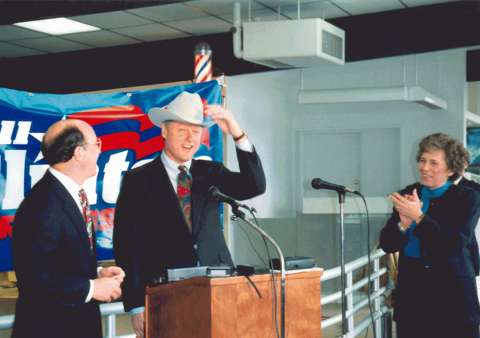
Karpan's opponent, Mike Enzi from Gillette, was a longtime Wyoming state senator making his first bid for statewide office. Enzi used the now tried-and-true formula of tying Karpan to incumbent President Clinton. In November 1996, most Wyoming voters started marking their ballots by voting for the Bob Dole-Jack Kemp ticket at the top and kept on voting Republican, giving Enzi 54 percent of the vote to Karpan’s 42 percent. “You could just feel, about two weeks out, the support evaporating,” said Karpan.
In the Clinton administration
Despite the antipathy of Wyoming voters, President Clinton won re-election handily with the help of voters from other states. He previously had offered Karpan a high-level position in his first administration; she turned it down because she wanted to finish her term as secretary of state. But with that no longer an obstacle, an offer was made again, and the U.S. Senate confirmed Karpan as director of the Office of Surface Mining, Reclamation and Enforcement (OSMRE) in July 1997.
“Lightning” in the form of difficult issues followed Karpan to OSMRE. After her confirmation, the agency became embroiled in an intense controversy that tested Karpan’s skills—over mountaintop removal mining in eastern U.S. coalfields. “My father was a coal miner, and it is not in me to get rid of coal mining jobs,” Karpan said. “But I also believe that we need regulation to address the impacts of coal mining.”
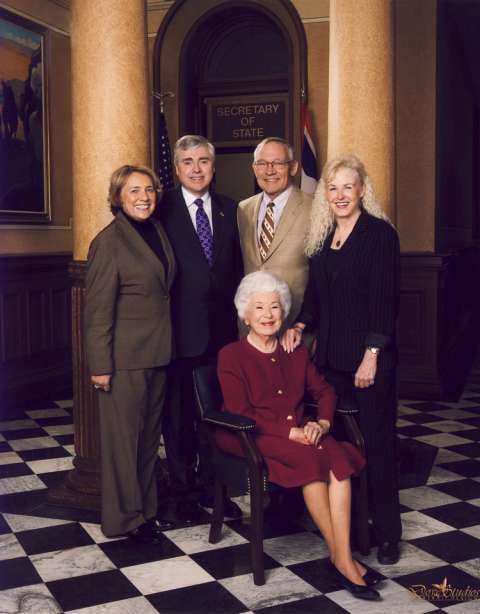
Shortly before Karpan’s arrival, OSMRE had begun a “Clean Streams Program” in abandoned mine lands; Karpan carried this program forward and began budgeting money for nonprofit community-based organizations to receive grants for this purpose.
Karpan’s tenure at OSMRE also brought her full circle to her first Washington job with Rep. Teno Roncalio. One of OSMRE’s responsibilities is to reclaim abandoned mine lands, using funds generated from a tax on current coal mine production, a program that resulted from a bill sponsored by Roncalio, who had advocated the measure because of coal mine subsidence problems in Rock Springs.
“I played around a mine mouth in No. 4 closed off by only two 2x4s,” Karpan said, recalling her childhood and referring to that mine’s structure at the time. “I couldn’t even fathom back then that 20 years later, a federal law would authorize reclamation of the sites, or that 40 years later, I’d head the agency that administered the law.”
Karpan’s attempts to take a measured approach to controversial issues before OSMRE pleased no one. After two and a half years at the helm of OSMRE, she moved on to spend another year and a half as Principal Assistant Secretary of Interior for Lands and Minerals Management.
Back to Wyoming law
The inauguration of President George W. Bush in January 2001 sent Karpan back to Wyoming to resume her law practice at Karpan and White, P.C., in Cheyenne, where she remains today.
Of her longtime legal partner, Margy White says, “Kathy has an enviable sense of humor. My personal favorite story of Kathy practicing law arose from a deposition she took of a person who had only a fleeting acquaintance with the concept of truth. After the deposition, Kathy said if and when we called this person to testify at trial, she would say, 'the plaintiff would like to call Pinocchio to the stand.'”
“The thing about Kathy,” added White, “is she’ll always talk about what other people have done. She never talks about herself, even though she does everything.”
As she still does, sitting at a conference table in her law office, alternately considering a legal matter and commenting on the 2016 presidential primary. “The law is interesting,” Karpan says, but admits with a smile, “politics is my first love.”
Resources
- Karpan, Kathy M. Personal interviews with author, Jan. 15, 2016, and Jan. 26, 2016.
- McDaniel, Rodger. Personal interview with author, Feb. 2, 2016.
- White, Margy M. Personal interviews with author, Jan. 15, 2016, and Feb. 16. 2016.
- White, Philip. Personal interview with author (including the information about the publication, Free Lunch), Feb. 16, 2016.
- Wyoming Secretary of State. 1983 Wyoming Official Directory. Compiled by Thyra Thomson, Secretary of State; Linda Mosley, Deputy; Kathy Wilson, Publications. Cheyenne: State of Wyoming, 1983.
- Wyoming Secretary of State. 1987 Wyoming Official Directory and 1986 Election Returns. Compiled by Kathy Karpan, Secretary of State; Margy White, Deputy; Dawn Hill, Editor. Cheyenne: State of Wyoming, 1987.
- Wyoming Secretary of State. 1991 Wyoming Official Directory and 1990 Election Returns. Compiled by Kathy Karpan, Secretary of State; Margy White, Deputy; Dawn Hill, Editor. Cheyenne: State of Wyoming, 1991.
- Wyoming Secretary of State. 1995 Wyoming Official Directory and 1994 Election Returns. Compiled by Diana J. Ohman, Secretary of State; Patricia O’Brien Arp, Deputy; Dawn Hill, Editor. Cheyenne: State of Wyoming, 1995.
For further reading and research
- White, Phil. “50 years ago today: Inspiring JFK drew crowds on Wyoming tour.” Casper Star-Tribune, Sept. 25, 2013. Accessed Feb. 26, 2016 at http://trib.com/news/state-and-regional/govt-and-politics/years-ago-today-inspiring-jfk-drew-crowds-on-wyoming-tour/article_591d01c3-f024-5ddc-8ef9-bc52afd05a5a.html
Illustrations
- The photo of Kathy Karpan with President John Kennedy and Sen. Gale McGee is courtesy of Phil White. Used with permission and thanks. The rest of the photos are from the Wyoming State Archives. Used with permission and thanks.
[1] Sarah Gorin, the author of this article, was the lead plaintiff in the lawsuit.
